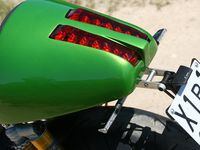For four decades, Grand Prix race mechanic Giuseppe Pattoni dedicated his life to constructing the distinctive green Paton racebikes. In the 1960s and early ’70s, a mere dozen of the Italian DOHC, 500cc parallel-twin Bicilindrica machines were built and raced with moderate success. Yet it was only after his death in 1999 that Giuseppe Pattoni’s dream of seeing his bikes become race winners came true. This happened after son Roberto dusted off the designs for the eight-valve version of the 500 Bicilindrica to build for classic racing, where it has seen the top step of the podium.
Fulfilling his dad's desire for success on the racetrack is one thing, but Roberto Pattoni has gone a step further: a Paton streetbike, which debuted at Milan's EICMA show last November. "We didn't make a big deal about launching the streetbike, just put it on our stand and waited to see what the public's response would be so we could learn if there'd be a market for it," Pattoni says with a smile. "It took about half a day for people to become aware of what it was because we've deliberately tried to be faithful to Paton's heritage by making it appear to be a racer that just happens to carry lights and a horn." Paton has so far sold 14 examples of the handmade S1 Strada at 16,000 euros plus tax, with deliveries set to begin in September.
So what do you get for that? Well, the S1 Strada is indeed very much a racer with lights. To create the S1, designer Andrea Realini slotted a Kawasaki 650cc parallel-twin motor into a Bicilindrica-replica race frame made from cold-drawn steel rather than the racer's chrome-moly. In all, the Strada follows its racing predecessor by being light (348 pounds, dry), compact (wheelbase is just 54.7 inches), and slim (the 4.2-gallon aluminum tank has generous knee cutouts). Minor mods accommodate the Kawasaki twin.
In spite of the Strada’s racing stance, there isn’t undue weight on your shoulders and wrists, though it’s hard to get tucked away behind the ultra-low screen even on a long, straight stretch of open road. This is not a nervous bike, thanks to the conservative steering geometry; it’s also forgiving so that if you misjudge your turn speed and have to brake as you bend it in, the Paton doesn’t sit up on you and head for the wheat fields. It’s a bike you feel totally in charge of.
It is also surprisingly quick, despite the Kawasaki’s modest 71-hp claimed output. In fact, even though power continues to hold after the 8,500-rpm peak, there’s no real need to rev the punchy little motor anywhere near its 11,000-rpm redline. Short-shifting at 8,000 rpm gives you satisfying performance because you’re in the fat part of the torque curve. Vibration is very well controlled.
The Paton S1 is living proof that less can indeed be more, provided you have a handling package that delivers the goods, as this one does. It’s a sweet little bike, and while it certainly isn’t cheap, the Paton order book shows there are customers out there for a sportbike with accessible performance, no concerns about engine reliability, heritage in spades, and that looks like a million dollars but costs significantly less—the Strada is just one-fifth of the price of the Paton classic racer it so closely resembles.



















/cloudfront-us-east-1.images.arcpublishing.com/octane/VZZXJQ6U3FESFPZCBVXKFSUG4A.jpg)
/cloudfront-us-east-1.images.arcpublishing.com/octane/QCZEPHQAMRHZPLHTDJBIJVWL3M.jpg)
/cloudfront-us-east-1.images.arcpublishing.com/octane/HXOUJXQWA5HBHGRO3EMJIGFMVI.jpg)

/cloudfront-us-east-1.images.arcpublishing.com/octane/3TIWWRV4JBBOLDVGRYECVVTA7Y.jpg)
/cloudfront-us-east-1.images.arcpublishing.com/octane/KIX5O23D5NAIBGFXBN3327DKZU.jpg)
/cloudfront-us-east-1.images.arcpublishing.com/octane/7GJYDUIPXRGMTMQKN6ONYOLBOU.jpg)
/cloudfront-us-east-1.images.arcpublishing.com/octane/MUQLOVLL2ZDGFH25ILABNBXKTI.jpg)
/cloudfront-us-east-1.images.arcpublishing.com/octane/TNOU5DNE2BC57MFPMGN2EIDXAM.jpg)
/cloudfront-us-east-1.images.arcpublishing.com/octane/GTCXACQGJ5HAPDTGWUQKDEH44E.jpg)
/cloudfront-us-east-1.images.arcpublishing.com/octane/S35YGSEMEZB4BLTDJTSZPF4GLA.jpg)
/cloudfront-us-east-1.images.arcpublishing.com/octane/5UOT6HPX2JFMRJAX6EH45AR4MQ.jpg)
/cloudfront-us-east-1.images.arcpublishing.com/octane/OKWOJWAKP5EP3OACCRRWPCIX2Q.jpg)
/cloudfront-us-east-1.images.arcpublishing.com/octane/2WF3SCE3NFBQXLDNJM7KMXA45E.jpg)
/cloudfront-us-east-1.images.arcpublishing.com/octane/G4MG6OUCJNBSHIS2MVVOTPX65E.jpg)
/cloudfront-us-east-1.images.arcpublishing.com/octane/IIGGWFOTOJGB7DB6DGBXCCMTDY.jpg)
/cloudfront-us-east-1.images.arcpublishing.com/octane/QSTCM6AVEZA5JJBUXNIQ3DSOF4.jpg)
/cloudfront-us-east-1.images.arcpublishing.com/octane/U4I7G625B5DMLF2DVIJDFZVV6M.jpg)
/cloudfront-us-east-1.images.arcpublishing.com/octane/B6XD6LS6IVCQPIU6HXDJSM3FHY.jpg)
/cloudfront-us-east-1.images.arcpublishing.com/octane/ICL63FEDDRDTTMINYICCEYGMDA.jpg)
/cloudfront-us-east-1.images.arcpublishing.com/octane/FCGZHQXRBZFLBAPC5SDIQLVF4I.jpg)
/cloudfront-us-east-1.images.arcpublishing.com/octane/WNOB6LDOIFFHJKPSVIWDYUGOPM.jpg)

/cloudfront-us-east-1.images.arcpublishing.com/octane/X33NU3E525ECRHXLNUJN2FTRKI.jpg)